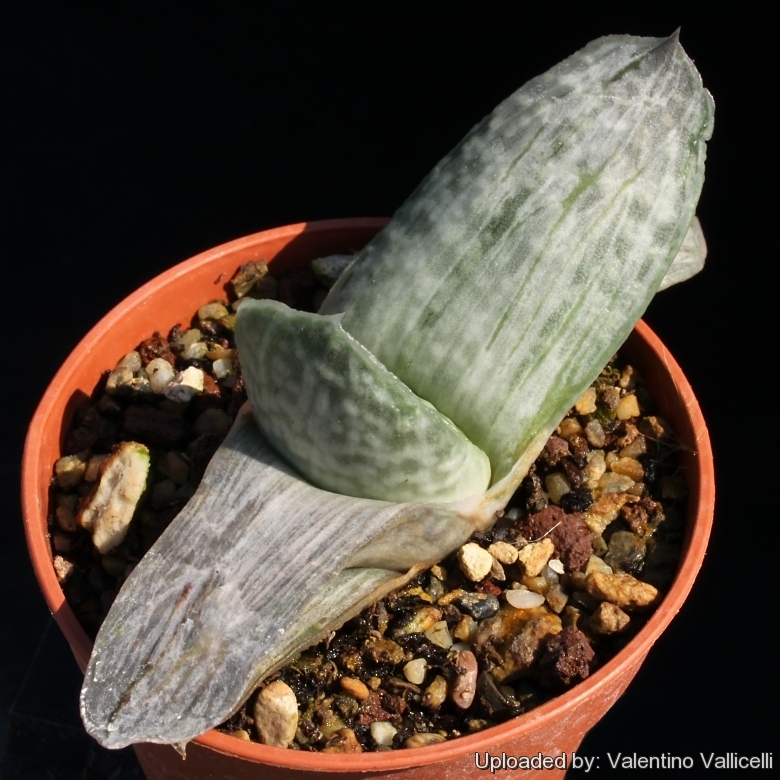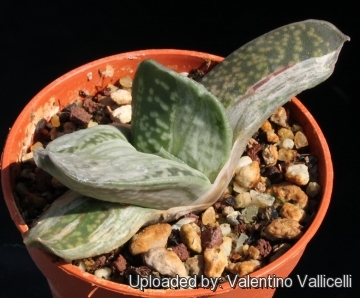= Gasteria nigricans var. marmorata f. variegata
Accepted Scientific Name: Gasteria brachyphylla
Aloe 29: 19 1992.

Gasteria obtusa f. variegata cv. Silver (Gasteria nigricans var. marmorata f. variegata) Photo by: Valentino Vallicelli
Synonyms:
See all synonyms of Gasteria brachyphylla
Description: Has fat coriaceus leaves striped with ridged surface of gray-silver and ivory.
Subspecies, varieties, forms and cultivars of plants belonging to the Gasteria brachyphylla group
 Gasteria brachyphylla (Salm-Dyck) van Jaarsv.: (var. brachyphylla) has leaves 90–230 mm long, 30–80 mm wide with a pointed leaf tip. Distribution: Little Karoo south of the Swartberg and northwards to Willowmore.
Gasteria brachyphylla (Salm-Dyck) van Jaarsv.: (var. brachyphylla) has leaves 90–230 mm long, 30–80 mm wide with a pointed leaf tip. Distribution: Little Karoo south of the Swartberg and northwards to Willowmore.- Gasteria brachyphylla var. bayeri van Jaarsv.: smaller, leaves only 15-50 mm long, with truncated leaf-ends. Inflorescence to 28 cm long and the flowers (perianth 18 mm) large for such a small plant. Distribution: Little Karoo, near Ladismith and Calitzdorp.
 Gasteria nigricans var. marmorata f. variegata: has fat coriaceus leaves striped with ridged surface of gray-silver and ivory.
Gasteria nigricans var. marmorata f. variegata: has fat coriaceus leaves striped with ridged surface of gray-silver and ivory.
 Gasteria obtusa f. variegata cv. Silver (Gasteria nigricans var. marmorata f. variegata) Photo by: Valentino Vallicelli
Gasteria obtusa f. variegata cv. Silver (Gasteria nigricans var. marmorata f. variegata) Photo by: Valentino VallicelliSend a photo of this plant.The gallery now contains thousands of pictures, however it is possible to do even more. We are, of course, seeking photos of species not yet shown in the gallery but not only that, we are also looking for better pictures than those already present.
Read More... Cultivation and Propagation: It is of easy culture and can grow on window sills, verandas and in miniature succulent gardens where it is happy to share its habitat with other smaller succulent plants, or in outdoor rockeries.
Growth rate: It is a relatively slow-growing plant that offsets to form in age small clusters..
Soil: It is tolerant of a wide range of soils and habitats, but prefers a very porous potting mix to increase drainage. A non-acid soil is ideal. You can grow a plant in a 10-15 cm pot for years and have perfectly happy plants. For best results, use a shallow pot.
Exposure: Need light shade to shade, but will take full sun part of the day. (with some sun exposure the leaf develops a nice reddish tint and remain compact) During the hot summer months, the soil should be kept moist but not overly wet.
Watering: During the hot summer months, the soil should be kept moist but not overly wet. During the winter months, water only when the soil becomes completely dry. Wet soil quickly causes root and stem rot, especially during chilly winter months. No water should ever be allowed to stand around the roots. Low ambient humidity is always needed.
Feeding: The plants are fertilized only once during the growing season with a balanced fertilizer diluted to ½ the recommended strength.
Hardiness: During the winter months, water only when the soil becomes completely dry. Frost hardy to -1°C (Or less).
Pest and diseases: Rot is only a minor problem with Gasteria if the plants are watered and “aired” correctly. If they are not, fungicides won't help all that much. Incorrect watering, poor drainage or too much shade can lead to attack by pests and diseases. Care must be given in watering, keeping them warm and wet while growing, and cooler and dry when dormant.
Remarks: Gasterias are best planted in a shaded and airy part of the greenhouse, and not too close to the glass roof or sides of the house as the plants can overheat during hot spells.
Propagation: Gasterias are easily propagated by the removal of offshoots or by leaf cuttings in spring or summer. To propagate by leaf cuttings, remove a leaf and let it lie for about one month, giving the wound time to heal. Then lay the leaf on its side with the basal part buried in the soil. This leaf should root within a month or two, and small plants will form at the leaf base. They can also grown from seed.
More...











